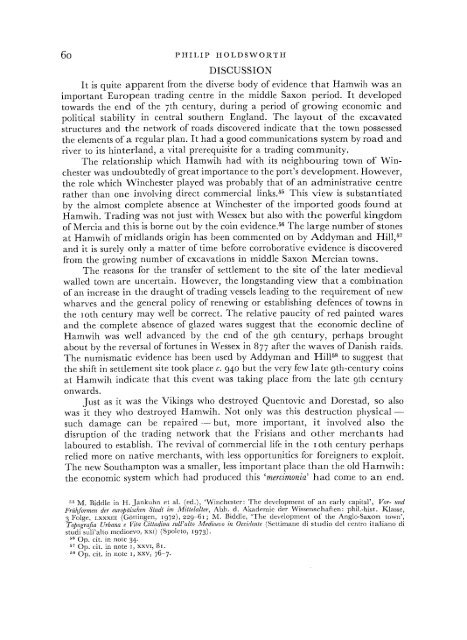Saxon Southampton; a New Review - Archaeology Data Service
Saxon Southampton; a New Review - Archaeology Data Service
Saxon Southampton; a New Review - Archaeology Data Service
You also want an ePaper? Increase the reach of your titles
YUMPU automatically turns print PDFs into web optimized ePapers that Google loves.
60 PHILIP HOLDSWORTH<br />
DISCUSSION<br />
It is quite apparent from the diverse body of evidence that Hamwih was an<br />
important European trading centre in the middle <strong>Saxon</strong> period. It developed<br />
towards the end of the 7th century, during a period of growing economic and<br />
political stability in central southern England. The layout of the excavated<br />
structures and the network of roads discovered indicate that the town possessed<br />
the elements of a regular plan. It had a good communications system by road and<br />
river to its hinterland, a vital prerequisite for a trading community.<br />
The relationship which Hamwih had with its neighbouring town of Winchester<br />
was undoubtedly ofgreat importance to the port's development. However,<br />
the role which Winchester played was probably that of an administrative centre<br />
rather than one involving direct commercial links. 55 This view is substantiated<br />
by the almost complete absence at Winchester of the imported goods found at<br />
Hamwih. Trading was not just with Wessex but also with the powerful kingdom<br />
of Mercia and this is borne out by the coin evidence.56 The large number ofstones<br />
at Hamwih of midlands origin has been commented on by Addyman and Hill,57<br />
and it is surely only a matter of time before corroborative evidence is discovered<br />
from the growing number of excavations in middle <strong>Saxon</strong> Mereian towns.<br />
The reasons for the transfer of settlement to the site of the later medieval<br />
walled town are uncertain. However, the longstanding view that a combination<br />
of an increase in the draught of trading vessels leading to the requirement of new<br />
wharves and the general policy of renewing or establishing defences of towns in<br />
the roth century may well be correct. The relative paucity of red painted wares<br />
and the complete absence of glazed wares suggest that the economic decline of<br />
Hamwih was well advanced by the end of the 9th century, perhaps brought<br />
about by the reversal offortunes in Wessex in 877 after the waves ofDanish raids.<br />
The numismatic evidence has been used by Addyman and Hi1l 58 to suggest that<br />
the shift in settlement site took place c. 940 but the very few late 9th-century coins<br />
at Hamwih indicate that this event was taking place from the late 9th century<br />
onwards.<br />
Just as it was the Vikings who destroyed Quentovic and Dorestad, so also<br />
was it they who destroyed Hamwih. Not only was this destruction physicalsuch<br />
damage can be repaired - but, more important, it involved also the<br />
disruption of the trading network that the Frisians and other merchants had<br />
laboured to establish. The revival of commercial life in the loth century perhaps<br />
relied more on native merchants, with less opportunities for foreigners to exploit.<br />
The new <strong>Southampton</strong> was a smaller, less important place than the old Hamwih:<br />
the economic system which had produced this 'mercimonia' had come to an end.<br />
55 M. Biddle in H. Jankuhn et al. (ed.), 'Winchcster: The development of an early capital', Vor- und<br />
Friihformen der eurapaischen Stadt im Mittelalter, Abh. d. Akademic der Wissenschaften: phil.-hist. Klasse,<br />
3 Folge, LXXXIII (Gbttingen, 1972),229-61; M. Biddle, 'The development of the Anglo-<strong>Saxon</strong> town',<br />
Topografia Urbana e Vita Cittadino sull'nlto Mediaeva in Occidente (Settimane di studio del ccntro italiano di<br />
studi sull'alto mcdioevo, XXI) (Spolcto, 1973)·<br />
56 Op. cit. in note 34-<br />
57 Op, cit. in note I, XXVI, 81.<br />
58 Op. cit. in note I, XXV, 76-7'

















